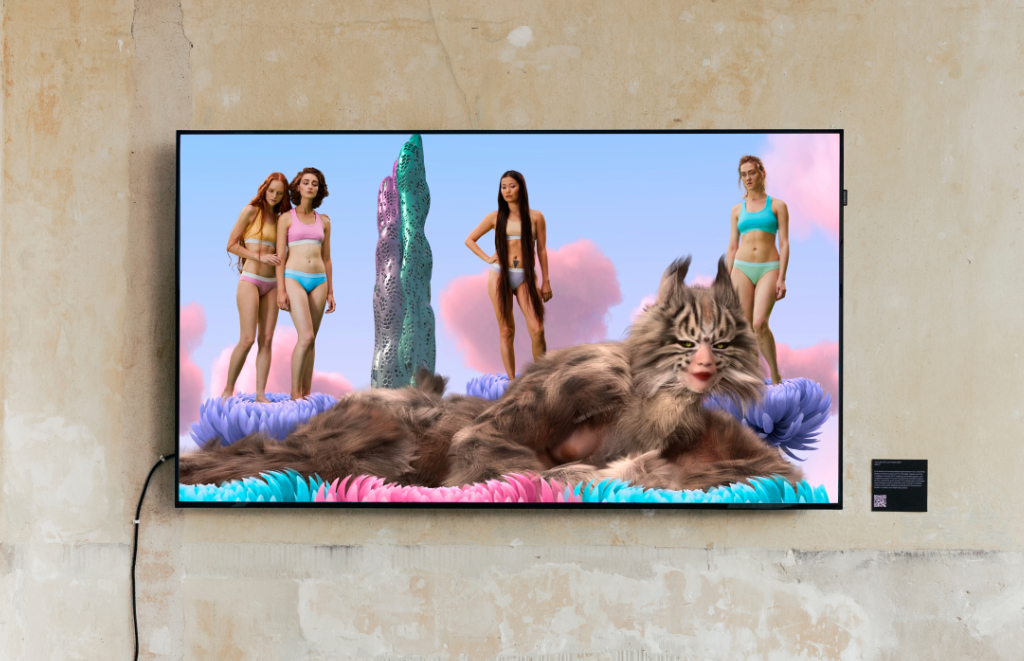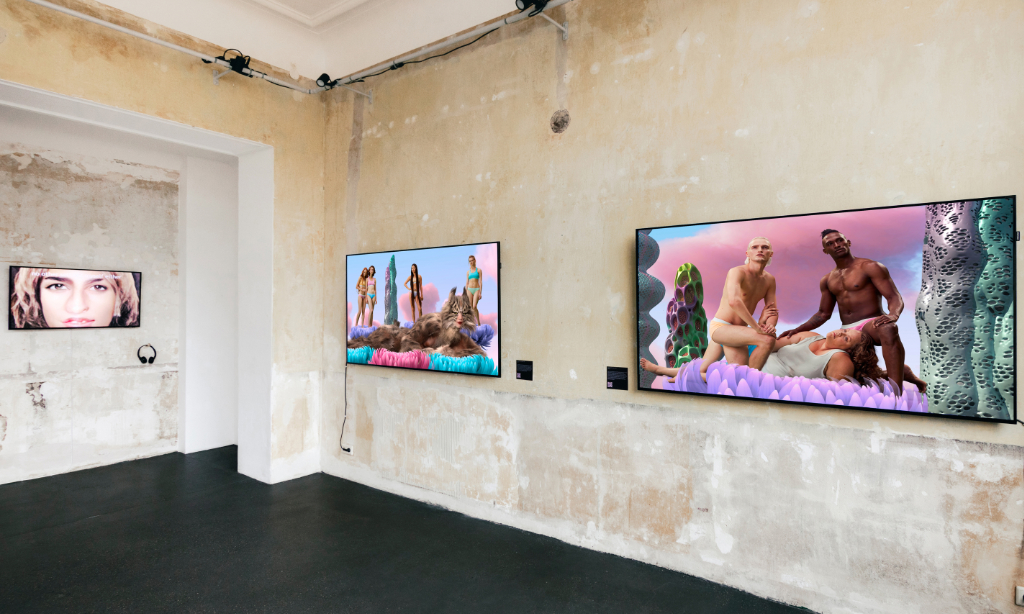Text by Lyndsey Walsh

Leaving the bubble that is realism, I KNOW – On The Aesthetic Of Truth invites audiences into the domain of what synthesis gallery founder, director, and curator George Vitale calls “Imaginative Truth” or “Anti-Realism”.
I KNOW – On The Aesthetic Of Truth is a collaboration between synthesis gallery and Feral File, which sets out to traverse the perilous landscape of truth. While technology has allowed us to be more connected to each other than ever before, we also live in a time when truth seems to be constantly slipping out of our grasp. It is a time where misinformation, fake news, and disinformation have been conveniently packaged in enticing branding to feed our need for unrelenting digital consumption.
The exhibition’s title references the declaration of the Italian artist and political figure Pier Paolo Pasolini, I know, but I have no proof from his famous column entitled ‘what is this coup d’état? I know’ published in the Italian newspaper Il Corriere della Sera in 1974. This publication is what is ultimately believed to have led to Pasolini’s subsequent murder in 1975 [1]. However, through a contemporary lens, it continues to raise important questions about truth and the use of creative formats and art in the narration and knowability of truth. The work’s subsequent critical reception has given way to the rise of two categories of truths: historic truths and aesthetic truths.
In contrast to historical truths that deal primarily with the historical realm of authenticity, the Italian academic Anna Lisa Tota defines aesthetic truths as truths that seek out an authenticity of the past as constructed by artistic and cultural modes and models in her 2017 article ‘I Know, But I Have No Proof’. Authentic Past and Aesthetic Truth in Post-War Italy. Tota further explains that while historical truths follow scientific conventions and rules that are standards in the field of history, aesthetic truths can convey that which cannot be directly addressed in historical accounts. These aesthetic truths often bring up issues concerning morality, allow room for memory, and articulate issues in ways that historical accounts simply cannot [2].
synthesis gallery has been making immersive exhibitions concerning art and technology since 2017, and I KNOW – On The Aesthetic Of Truth continues the gallery’s mission of merging virtual and physical worlds. The show’s physical dimensions inhabited the Salon am Moritzplatz in Berlin, while its virtual dimensions are primarily hosted by Feral File, a blockchain platform launched by Casey Reas that sets out to explore new ways of exhibiting and collecting art. The exhibition was a part of transmediale, and CTM’s Vorspiel 2023 program at Salon am Moritzplatz from the 2nd until the 5th of February.
The exhibition features a lineup of five international artists: Cibelle Cavalli Bastos, AES+F, aaajiao, Claudia Hart, and Yehwan Song. Vitale comments on the curatorial concept stating, With this exhibition, I am not trying to define what truth is. I am trying to define where truth should stand by. When it came to the artworks featured in the exhibition, Vitale asked each of the artists to revisit historical moments and find a place within it to rethink traditional modes of thinking of art in order to explore and present future possibilities.
As the audience, we enter the exhibition both as spectators and as investigators and embark on a journey of discovery through these artists’ creative visions, simultaneously engaging in the process of truth-making through our own interactions with the works. The artists themselves work to examine knowledge and the process of knowing by creating windows into different aspects of our world and cultural climate. The exhibition’s curatorial text elaborates that these artists struggle with power, inequality, and discrimination, addressing debates about mass surveillance and the architecture of the web3. It is from these struggles that they work to seek out something new and imaginative that can make valuable meanings in our post-truth world.



Right: A Picture Can’t Take Me, Cibelle Cavalli Bastos, (left). Turandot 2070, Lynx Avatar, AES+F (2021, center). Turandot 2070, Lovers I, AES+F (2021, right).
Berlin-based Brazilian artist Cibelle Cavalli Bastos’ A Picture Can’t Take My Elan Vital and A Picture Can’t Take Me traverses the realm of generative portraiture. The works use a data set of Google Search pictures of the artist taken when they were known as a cis woman signer and their own selfies taken while transitioning to non-binary and aging, derived from their Instagram and a personal archive spanning over 20 years of images.
The video work A Picture Can’t Take Me features a compilation of images as well as a poem that Bastos wrote on the impossibility of capturing subjectivity in portraiture, which they then passed it on to the AI pre-trained language model GPT2 to complete for them. While A Picture Can’t Take My Elan Vital singles out one of the still image outputs from Bastos’ process, the audiences in the Salon am Moritzplatz space can virtually also interact with through an AR filter.
These themes of challenging the knowledge of the algorithm and online collective archives also spill over into the work of Shanghai and Berlin-based aaajiao’s Prophecy, nullification algorithm, shaman, conspiracy, which aims to both provoke and initiate a discussion, as well as serve as instructions for how to engage with social media to challenge the power that we give to algorithms. The work’s animated and looped screen capture shows the random swiping of a phone keyboard to generate words, which are then posted online to feed and mess with data algorithms.
In addition to the Prophecy, nullification algorithm, shaman, conspiracy, aaajiao’s has dropped a new collection of NFTs with Feral File as part of the exhibition entitled Unzip. Unzip is a collection of 88 zip sub-packages that each contains an NFT. However, the zipped files can only be unzipped if the collector can collect all 88 of the zip sub-packages. In line with the disruption NFTs are bringing to the art world by shifting the movement of the art market, aaajiao’s Unzip asks if the act of trading, which is integral to the value system of NFTs, can also inspire curiosity and solidarity.
Much like aaajiao’s questioning of user experiences in our increasingly technological and digital world, South Korean artist and coder Yehwan Song’s works Artwork 1 & 2 set out to explore the unbalanced power dynamics and often hidden violence involved in the functionality of technology. The design and functionality of technologies are implicated by the assumptions used to create them, embodying the words of American historian Melvin Kranzberg’s First Law: Technology is neither good nor bad; nor is it neutral [3].
Song’s work explores through parody how technology actually works, thereby revealing how certain groups of people and users are left out by the design of the technology and can pay a hefty price when they are unable to benefit from its use. Both Artwork 1 & 2 are website-based, mutating virtual sculptures that have been shaped based on the inputs of touchscreens. Artwork 1 features a sculpture made from water dropping onto the touchscreen, while Artwork 2 follows suit in exploring this through the cracking of an egg on the touch-sensitive interface.
Also emerging from the lens of parody, American artist Claudia Hart’s The Art of Survival views NFTs as parodies of power. Two of the NFTs entitled Aphorisms by an Old Girl and Perfectionism is a weakness are also featured on Feral File.
Inspired by Machiavelli’s The Prince and Sun Tzu’s The Art of War, Hart’s work employs aphorisms, framed in aesthetic references to Times Square billboards and brandings slogan. These aphorisms generated by Hart and narrated by Queen Elizabeth (or her bot) display brightly coloured mottos decked out for a public address and are animated to captivate the attention of anyone who passes by them. Intended to heal a flaming world where many of our discussions have been polarized by social media and current real politics, Hart’s NFTs also have an AR component that is viewable at the Salon am Moritzplaz location.
Lastly, the exhibition features two excerpts entitled Lynx Avatar and Lovers I from the Paradise sequence of the Russian collective AES+F’s work Turnadot 2070, which created portals into a fantastical, colourful, and otherworldly vision at Salon am Moritzplatz location. These two excerpts are available for collection with Feral File and invite viewers into the scenes of the dramatic re-imagining of the early “globalised” fable Turnadot.
In Turnadot 2070 viewers are transported to a dystopian and high-tech future capital of Beijing, where the techno-feminist matriarchy Princess Turnadot rules over a totalitarian, global empire. In Lynx Avatar, Princess Turnadot takes the form of one of her Avatars while the masses submit to her in public displays that border on idolatry and mass hallucination. In Lovers I, follows this exploration of unsettling displays of public adoration while embedding references to contemporary media scandals and issues. Taking on the topics of #MeToo, cancel culture, and fake news, among others, AES+F interweaves contemporary collective fears and desires with the fantastical aesthetics of the alien and a yet familiar world that they have created.
Vitale’s final words for audiences to take away from the show invite a call to action as he beckons us to: Question, keep on asking questions. Don’t be dogma driven and even reject dogmas. Always look at the other side. Be willing to listen even to opinions that are not always comfortable, and I mean abrasive… We are so fast-paced in everything that we do that we have forgotten about thinking and we do not let memories and feelings sink in. It is a life that becomes meaningless more and more as we become tools of technology.
I KNOW – On The Aesthetic Of Truth takes a bold step forward with this call and endeavours to navigate how creativity and aesthetic truths can be used to stop us from following the governance of algorithms and find our own voices to guide us forward.





